
Introduction
ASUS is a company that generally needs no introduction. The company has been around since the 1980s and is a well-known staple of the DIY computing enthusiast market. While ASUS has branched out into a number of markets including monitors, laptops, desktops, and even mobile phones, the company is still best known for its full lineup of enthusiast motherboards.
Today we are taking a look at the ASUS TUF GAMING Z790-PRO WIFI motherboard. At the time of this writing, it costs around $279.99 at websites like Amazon.com and ASUS’ own estore site. This puts it in the midrange bracket for motherboard pricing, albeit towards the bottom of the midrange with as expensive as motherboards can be these days.
ASUS TUF GAMING Z790-PRO WIFI
The ASUS TUF GAMING Z790-PRO WIFI is based on Intel’s Z790 Express chipset and was introduced with the 13th generation Intel CPUs. Fortunately, motherboards using this chipset can support the current 14th-generation CPUs with a simple BIOS update. Being a Z790 Express chipset-based motherboard, the ASUS TUF GAMING Z790-PRO WIFI supports DDR5, PCIe 5.0, USB 3.2, and 2.5GbE LAN.
Inside the packaging, you’ll find the following accessories: A certificate of reliability, stickers, M.2 screws, a driver disc, wireless antennas and SATA cables. There isn’t a lot there, but you get everything you absolutely need to have.
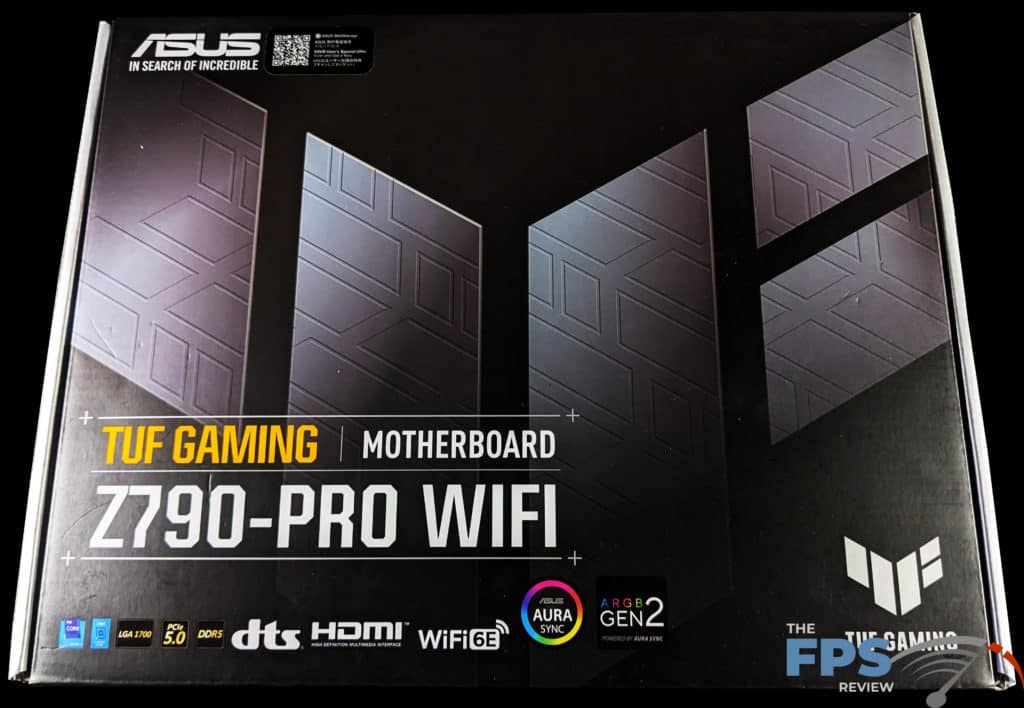
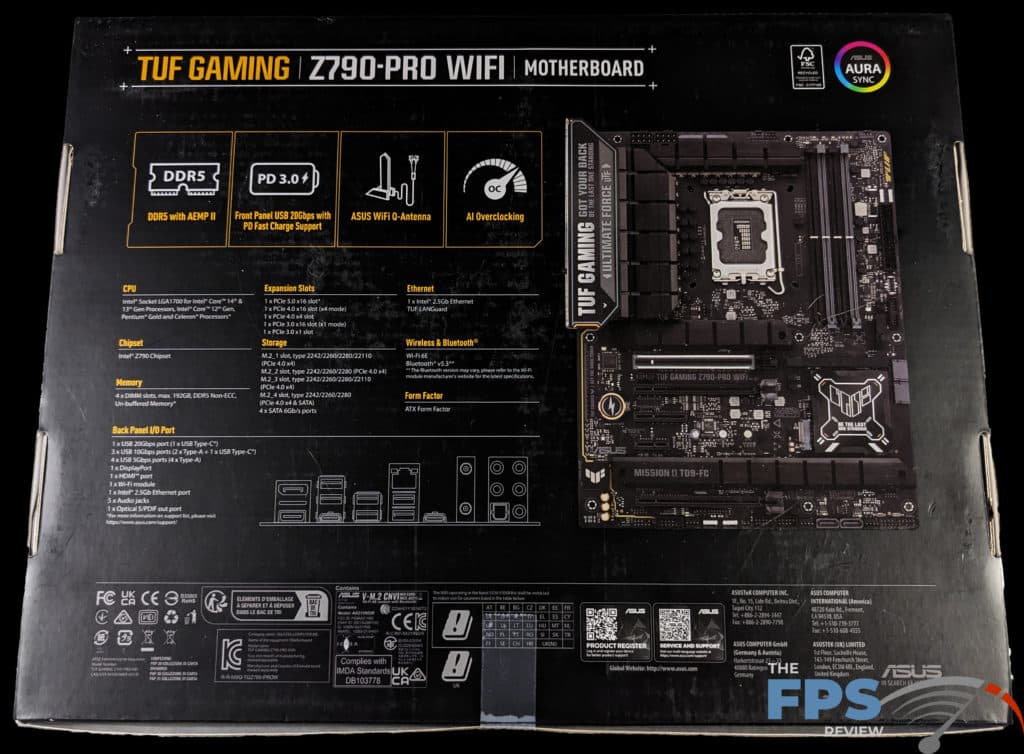

The ASUS TUF GAMING Z790-PRO WIFI Motherboard PCB & Features

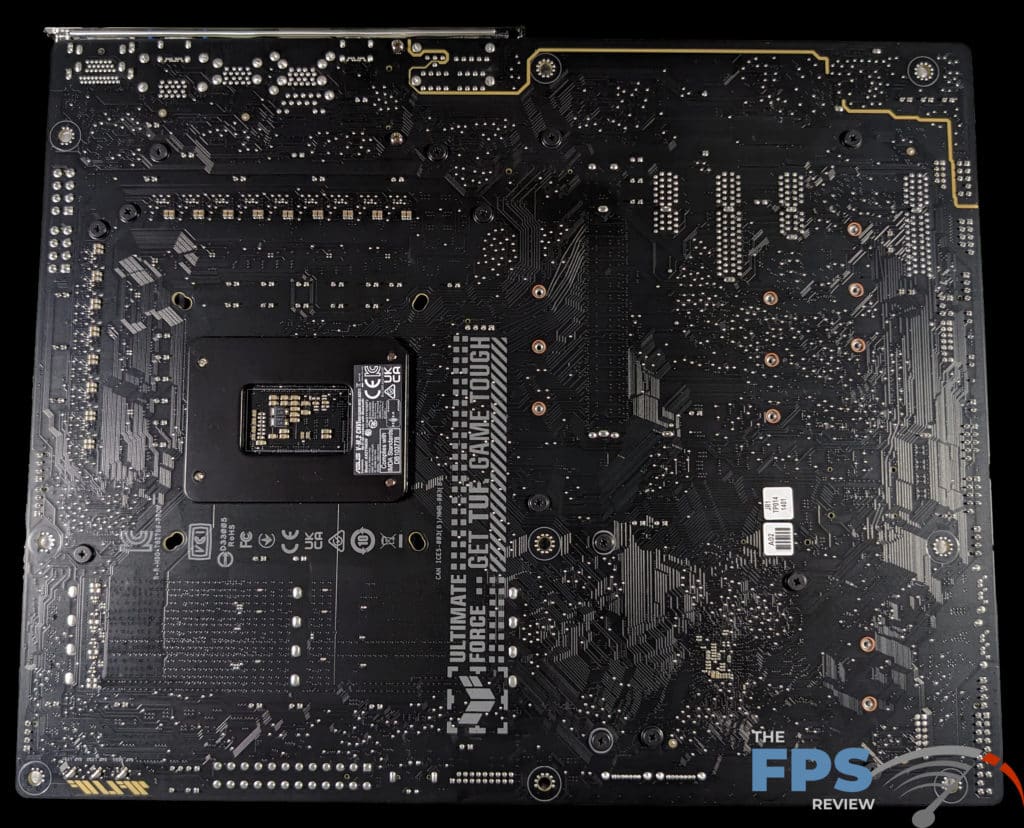
The ASUS TUF GAMING Z790-PRO WIFI is built on a 6-layer PCB which is pretty standard for the industry at lower price points. You will occasionally see 8 or more layers on ultra-high-end boards and workstation or server products. The layout of the ASUS TUF GAMING Z790-PRO WiFi is excellent with only one real flaw needing to remove your GPU before changing out the CMOS battery. Given how rarely this has to be done this shouldn’t be a big deal unless you have a custom water-cooling solution with hard tubing.
At this price point, ASUS has forgone most of the plastic cladding and thermal armor of the higher-end models. It does have some cladding around the built-in I/O shield which is pretty standard for any motherboard with a built-in I/O shield. The VRM heat sinks are very simple aesthetically and have a brushed-type finish. The finish is serviceable but these aren’t what I’d consider nice. The M.2 slots have covers that double as heat sinks which match the styling or lack of styling on the VRM heat sinks.
It’s also light on RGB lighting as the only lights present are the ones that light up a TUF logo embedded in the PCB itself. This nearly translucent part of the PCB illuminates even from ambient light as you can see in the photo on the bottom right-hand corner of the motherboard. The three RGB LED lights that make this feature work are visible from the back of the PCB as well but that’s it for the built-in lighting on this motherboard. People who hate RGB can rejoice at ASUS’ drastic reduction of RGB LEDs on the ASUS TUF GAMING Z790-PRO WIFI.
That said, ASUS still includes one standard RGB header and 3 addressable RGB headers. You will also find 2x CPU fan headers, 1x AIO pump header, and 4x 4-pin chassis fan headers. For power, the ASUS TUF GAMING Z790-PRO WiFi supports the standard 24-pin ATX and 2×8-pin connectors using their ProCool connectors. ASUS’ ProCool feature amounts to thicker pins used in the power connectors which enables them to carry more voltage without heating up as much.
Unfortunately, at this price point, ASUS doesn’t include POST code LED displays. ASUS does include its “QLED” feature which amounts to idiot lights on base model cars from the 1970’s and 1980 which are better than nothing but seriously lacking in functionality.
Power Delivery
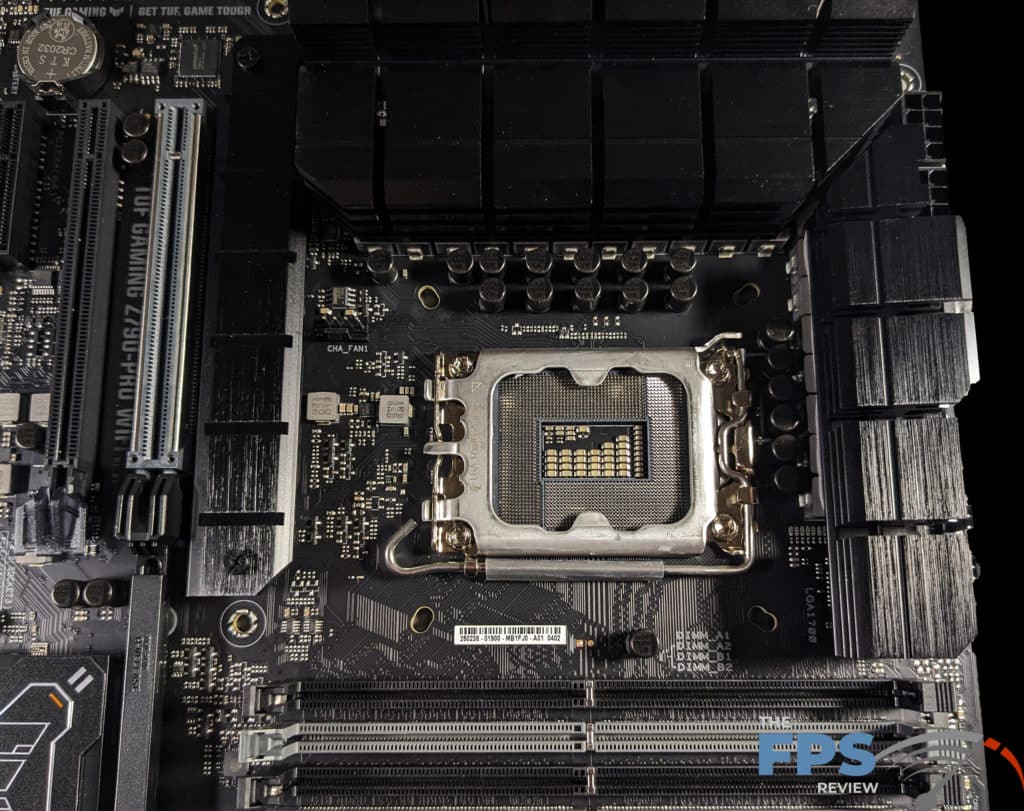
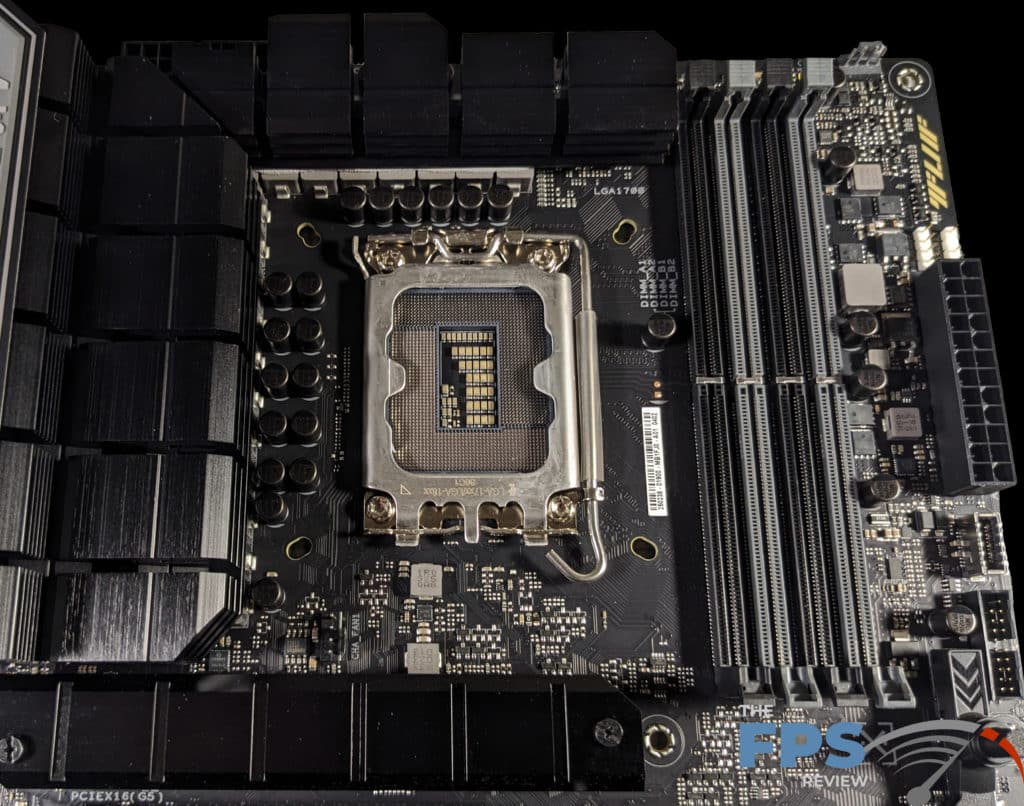
For power delivery, ASUS claims 16 power phases using 60A DrMOS MOSFETS, 1 phase for GT power, and 1 phase for auxiliary power. The former also uses a 60A DrMOS power stage but the latter probably doesn’t as the product page makes a distinction between the 60A phases used everywhere else and not for the AUX Power phase. For those that do not know, the DrMOS MOSFETs combine the high and low-side MOSFETs and Driver IC into a single package.
Rounding out the package are ASUS’ “TUF” capacitors which are rated at 5,000 hours. These supposedly have a 52% wider temperature tolerance, though it doesn’t say what this compares to. The language on the product page is purposely ambiguous and thus uses many words to essentially say nothing. ASUS also claims a 2.5x longer lifespan than standard capacitors though these statements on ASUS’ product page are dubious at best. 5K capacitors have been around for more than a decade and are fairly common now. Only truly entry-level boards would use worse capacitors today and the statement about a 2.5x longer lifespan doesn’t make sense when many motherboards use 10,000-hour rated capacitors.
ASUS also does make a statement about “TUF chokes” being certified military grade. This is probably true as there is a military standard for electronic components. However, this shouldn’t be taken to mean that these are the best chokes money can buy, as military standards indicate a floor for military hardware, not a ceiling.
Memory
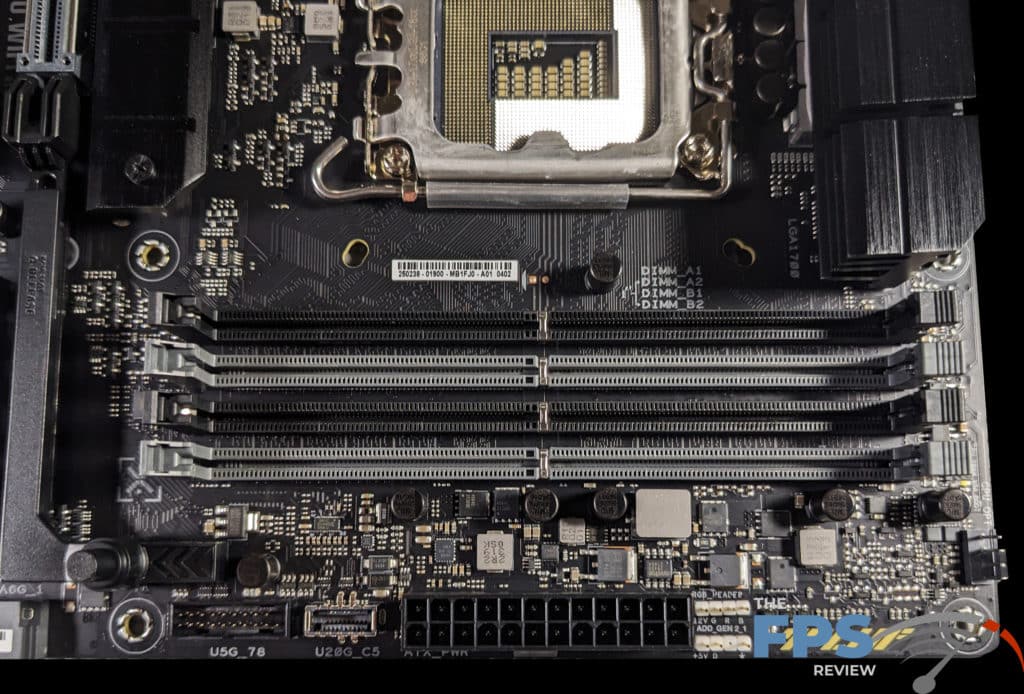
The ASUS TUF GAMING Z790-PRO WiFi supports 188-pin DDR5 DIMMs up to 48GB in size for a total of 192GB of RAM. Through overclocking, memory speeds up to 7800+ are possible. The DIMM slots do use single-sided locking tabs for module retention and are color-coded to denote proper dual-channel memory mode operation. The memory channel and bank arrangement are also clearly marked on the PCB which is always appreciated.
ASUS has a feature called Enhanced Memory Profile II or AEMP II which aims to improve memory performance and overclocking even when using PMIC-restricted modules without XMP or EXPO profiles. AEMP II also streamlines the configuration of 4x DIMM systems which can normally be problematic. This won’t result in achieving the same clocks as you’d get from a 2x DIMM configuration but it should ease the configuration process and allow for better clocks than you might get configuring it yourself. Even if it didn’t, anything to streamline the tuning would be appreciated. Though your mileage may vary quite a bit as there are a lot of variables involved here.
Expansion
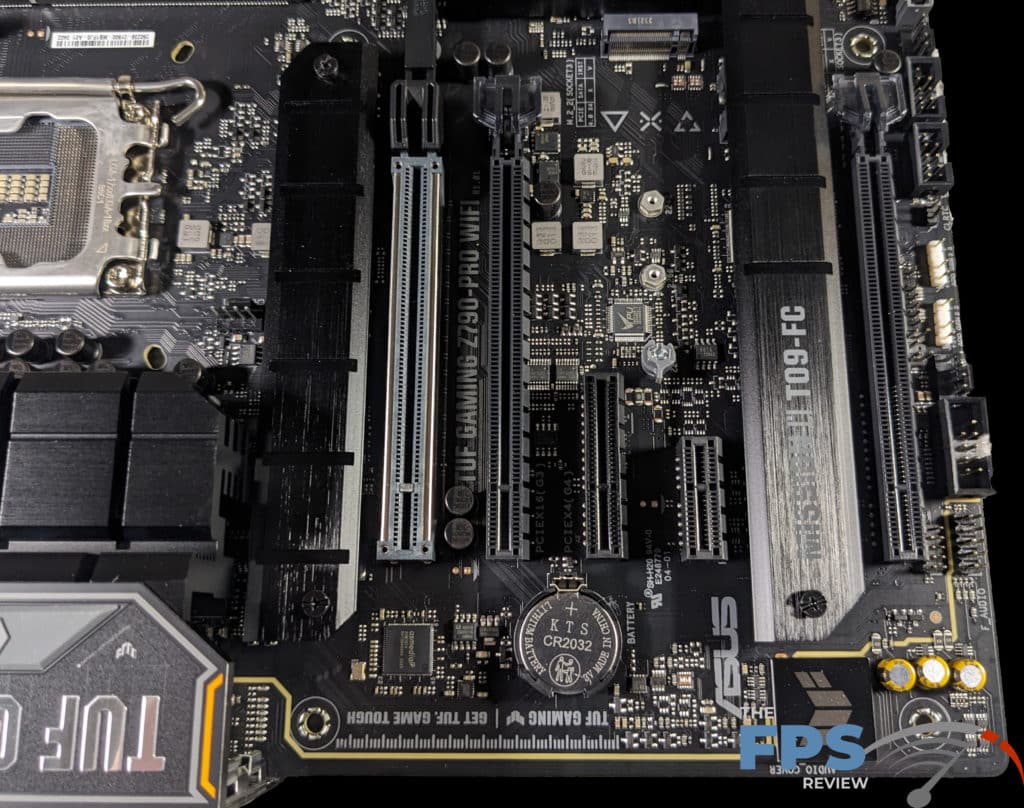

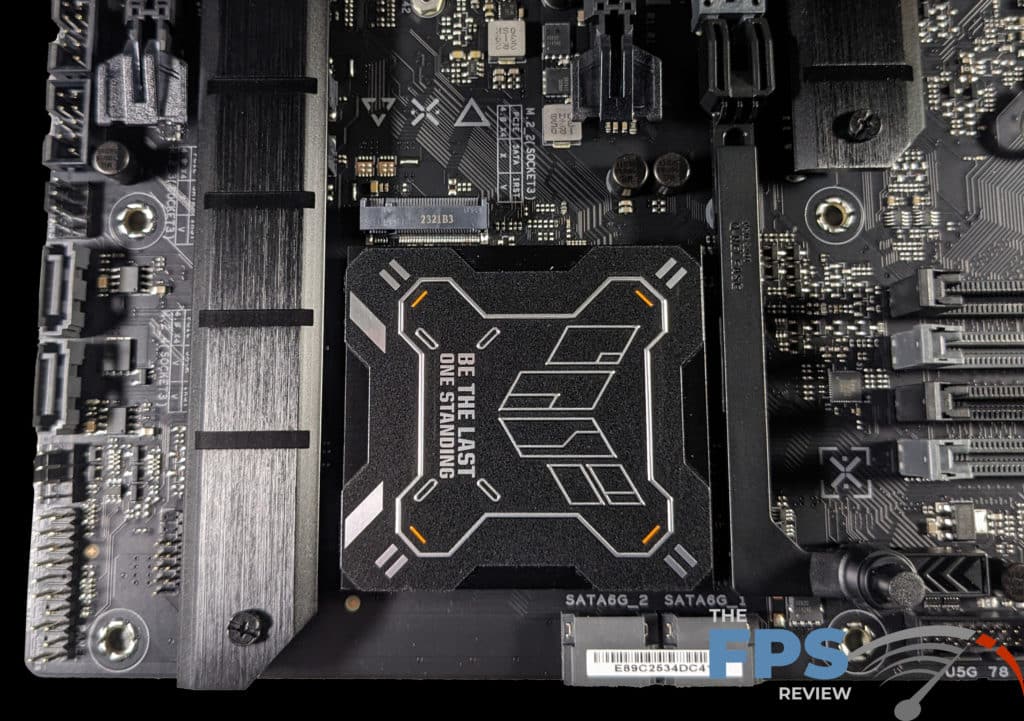
When it comes to expansion capability, the ASUS TUF GAMING Z790-PRO WiFi has a lot to offer. It offers a single PCIe x16 Gen 5.0 slot which is connected to the CPU’s PCI-Express controller. This slot is backward compatible with earlier PCIe generations. Some motherboards support a PCIe 5.0 compatible M.2 slot which would share bandwidth with the PCIe x16 5.0 slot reducing the lane count to x8 lanes. However, this isn’t the case with the ASUS TUF GAMING Z790-PRO WiFi. It has no PCIe 5.0 support on any M.2 slot.
Additionally, you get 2x PCIe x16 slots supporting x4 (gen 4.0) and x1 (Gen 3.0) lanes electrically. There is also a PCIe x4 (Gen 4.0) slot and one PCIe x1 (Gen 3.0) slot as well.
For M.2 slots, there are four of those. Two of which support devices up to 110mm long and the other two are limited to type 2280 (80mm long) devices. Additionally, there are slots supporting PCIe/NVMe modes and one that supports SATA-type devices as well. All but one of these has a cover on it that acts as a heat sink and sports the same aesthetics as the VRMs do. ASUS uses its M.2 Q-latch system on these slots making M.2 devices far more pleasant to use than they normally are.
For USB connectivity, there are 8x USB ports on the back panel which are a mixture of Type A and Type C ports at various speeds ranging from 5Gbps to 20. There are another 7 available USB ports via internal headers. Again these are mixed types.
Audio Hardware
The ASUS TUF GAMING Z790-PRO WiFi integrates a Realtek S1220A 7.1 HD channel audio CODEC. ASUS advertises the following specifications for the audio implementation:
– Impedance sense for front and rear headphone outputs
– Internal audio Amplifier to enhance the highest quality sound for headphone and speakers
– Supports: Jack-detection, Multi-streaming, Front Panel Jack-retasking
– High quality 120 dB SNR stereo playback output and 113 dB SNR recording input (Line-in)
– Supports up to 32-Bit/192 kHz playback*”
Audio Features
– Audio Shielding
– Rear optical S/PDIF out port
– Premium audio capacitors
– Dedicated audio PCB layers
– Audio Cover
– Unique de-pop circuit
* Due to limitations in HDA bandwidth, 32-bit/192 kHz is not supported for 7.1 Surround Sound audio.
Realtek S1220A 7.1 Surround Sound High Definition Audio CODEC*
– Impedance sense for front and rear headphone outputs
– Internal audio Amplifier to enhance the highest quality sound for headphones and speakers
– Supports: Jack-detection, Multi-streaming, Front Panel Jack-retasking
– High-quality 120 dB SNR stereo playback output and 113 dB SNR recording input (Line-in)
– Supports up to 32-Bit/192 kHz playback*”
There is a lot to unpack there but mainly it’s important to note that the implementation uses separate PCB layers for the left and right channels, has a de-pop circuit that eliminates the annoying pop when connecting devices, and has impedance detection. This is a great implementation of the Realtek S1220A HD audio CODEC, but it’s pretty standard for ASUS.
Networking
The ASUS TUF GAMING Z790-PRO WiFi offers both a wired and wireless solution for network connectivity. The wired controller is a 2.5GbE Intel i226-V. Intel’s AX211 (WiFi-6) 160MHz controller is used for wireless connectivity. The i226-V wouldn’t have been my first choice as Intel’s i22x series hasn’t been without its problems in the past. The wireless however generally works well and Intel’s offerings are practically the gold standard for such controllers.
Rear I/O Panel
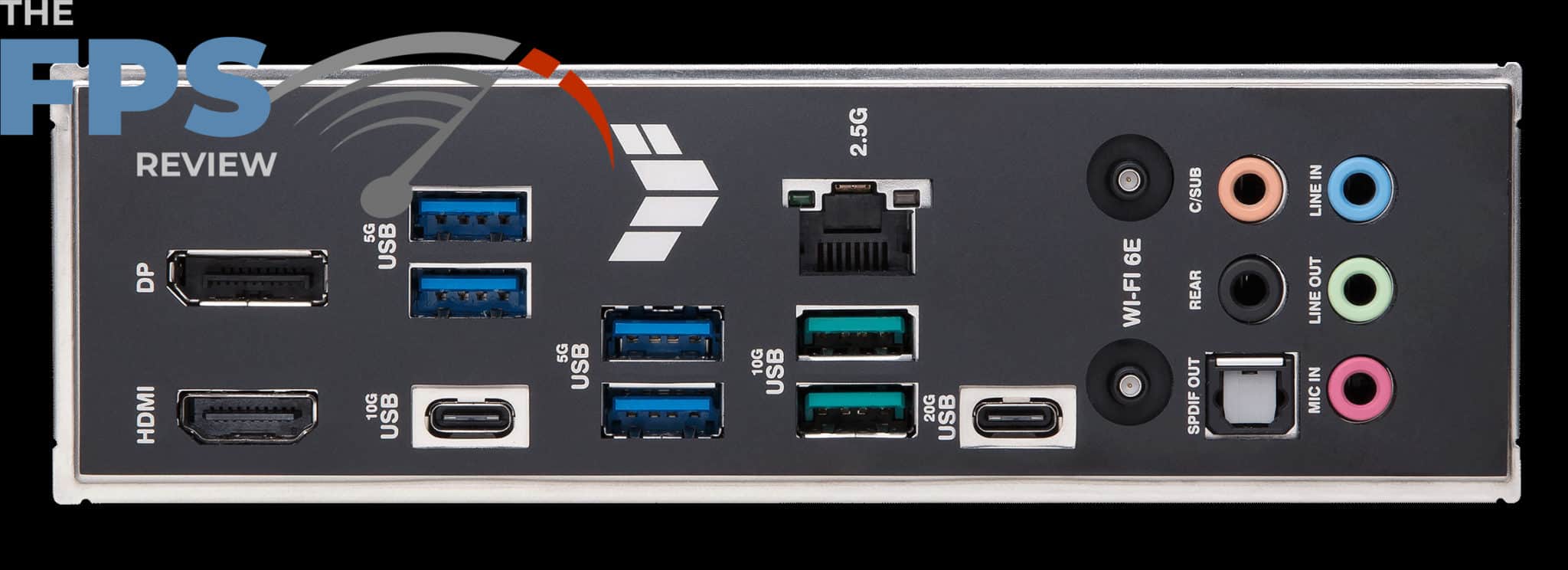
On the rear I/O panel, you’ll find a mix of USB Type A and Type C ports of varying speeds. You will also find an HDMI and a DisplayPort connection alongside RJ-45, 5x mini-stereo jacks, 1x optical output, and two wireless antenna jacks.
BIOS
The ASUS TUF GAMING Z790-PRO WIFI uses a 192 (128+64) Mb UEFI Flash ROM which is licensed by American Megatrends Inc. It supports the usual management stuff such as WOL by PME, PXE, etc. For all testing, we used the latest BIOS from ASUS at the time of this writing which is version 1403. It is dated 9/27/23.




The BIOS on the ASUS TUF GAMING Z790-PRO WiFi has basically the same UEFI implementation that all its motherboards have been using for around a decade or so. However, the implementation has been iterated over time, and it’s quite a bit different today than it was in the early days. Though it’s still laid out about the same and thus remains easily recognizable even in its current form.




I’m not the only one who thinks so given how many manufacturers essentially copy the layout and design of ASUS’ UEFI to varying degrees of success. Among the more recent additions to the ASUS UEFI BIOS implementation is its EZ mode. The EZ-Mode is pretty much the standard for most companies these days. Though I’m sure there are some exceptions. The EZ mode is a simple menu that allows you to see a condensed version of many BIOS settings, features, and menus. This can make setting up the system easier for novices who may find the advanced mode a bit intimidating.




The EZ-Mode also provides everything you need for monitoring basic system health and even provides options for basic performance-related system tuning such as enabling the XMP settings for your memory. The EZ mode includes wizards for just about everything from setting up your fans to creating a RAID array.



All that said, just about every manufacturer offers largely the same features and settings in their UEFI BIOS implementations. On any modern motherboard, you won’t ever find yourself limited in your overclocking capability due to missing BIOS settings or a lack of tuning capability outside of potential hardware limitations these are relatively rare these days. However, what truly sets a UEFI implementation apart from the rest is the user experience and the tools built into it.
On that front, ASUS’ TUF GAMING Z790-PRO WiFi truly shines. The user experience is excellent as it is simple enough to use even with only a basic understanding of what it does while still being a “tuners BIOS” at the same time. Settings can generally be entered manually with the BIOS rounding up to the closest valid variable. Generally, you can see the auto-detected value and what is currently in use. You always have PC health information displayed on the right. There are pages and pages of settings for both CPU and memory tuning in the AI Tweaker menu.
There is a dedicated PC health menu which also contains the fan controls. The fan controls are handled through simple drop-down menus which allow you to select from a set of predefined profiles to control the fans. Manual modes are available as well to allow the user the ability to configure fan performance. ASUS also offers a BIOS flash utility, a user profile creator, an SSD secure erase program, and a memory SPD reader.
Each of these tools has been around for a long time though not every motherboard has all of them. The SSD erase utility is particularly uncommon, though not unheard of either. Many board manufacturers include them, though typically only on higher-end models. That being said, ASUS’ versions of these utilities are all extremely user-friendly and intuitive.
Test Setup
We have the latest BIOS installed, 1403, dated September 27th 2023. All of our testing was performed at the default settings from the BIOS except the memory, here we set the DRAM to the XMP-II profile for full speed on our memory.
For the OS setup note that we are on the latest 23H2 Windows 11 update with all incremental Windows updates applied at the time of writing.
As with other motherboards we have recently tested, we are providing the test results below to give an idea of what a user can expect in a pure stock installation. While the option for factory overclocking was available, we only tested the motherboard with a base configuration. With testing you will notice the lack of a Latency Mon test, a staple of our reviews, this is due to all attempts to test providing false high readings.
Subsystem Testing
SSD Performance


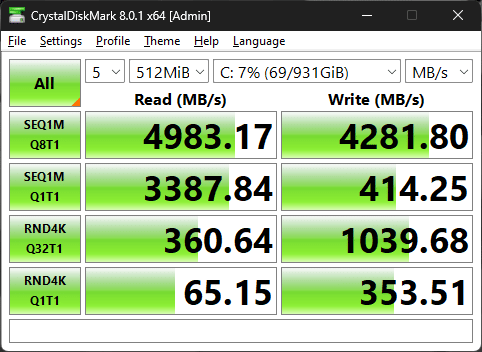
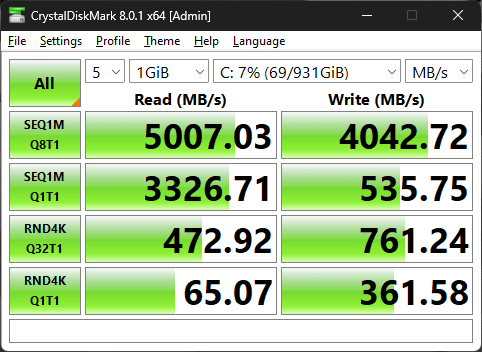
For this test, we used a Corsair MP600 1TB PCI-Express 4.0 compatible NVMe drive for our benchmark testing. Fortunately, there isn’t much to say about M.2 performance as the numbers are all perfectly in line with what we would have expected and consistent with the drive manufacturer’s specifications. Of course, this is a good thing as it indicates everything is working properly.
Application Benchmarks
Memory Bandwidth
For all of our memory tests, we used the ACER Predator Hermes DDR5 CL32 32GB memory kit running at DDR5 6800MHz. The XMP-II profile was used for all testing.
In this test, we see a memory read speed of 97957MB/s, a write speed of 91028MB/s, and a file copy speed of 90555MB/s.
PCMark 10

In this test, the ASUS TUF GAMING Z790-PRO WiFi achieved a score of 9546 points in the PCMark 10 test. This is right around what we would expect with this CPU and configuration.
Cinebench R23
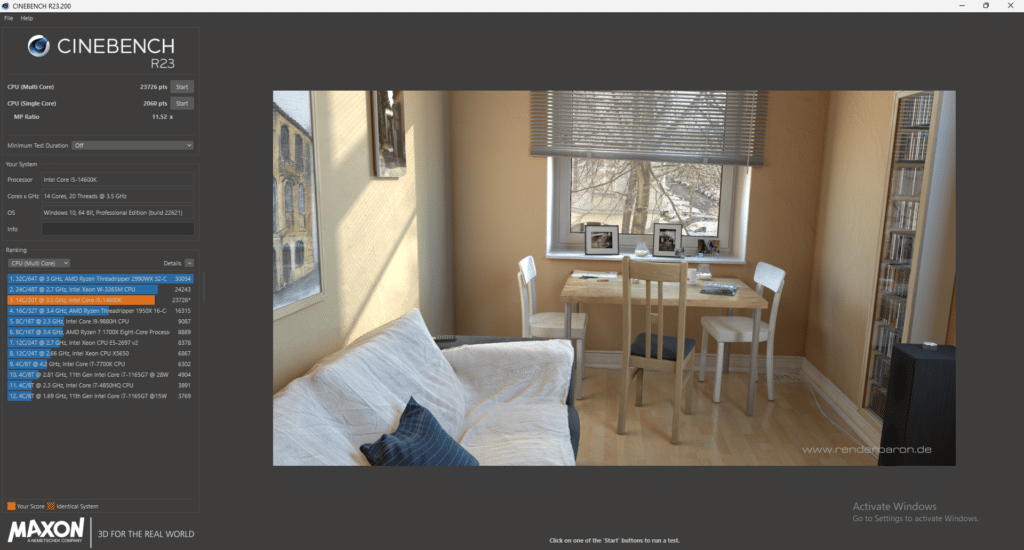
In our Cinebench R23 test, the ASUS TUF GAMING Z790-PRO WiFi scored a result of 23726 in the multithreaded test and 2060 points in the single-threaded test.
Blender Benchmark
In the Blender Benchmark, we achieved a result of 146.11 in Monster, 99.67 in Junkshop, and 74.40 in Classroom.
3DMark 10

In the 3DMark 10 CPU test, we achieved a result of 10765 in the max threads test and 1147 in the single thread test. Both are respectable scores for the CPU used.
V-Ray Benchmark
In our V-Ray test, the ASUS TUF GAMING Z790-PRO WiFi achieved a result of 16,632 K samples. Again, par for the course for this configuration.
Conclusion
At the time of this writing, the ASUS TUF GAMING Z790-PRO WIFI can be had at a price of about $279.99 from major online retailers. Feature-wise, the board has a lot to offer in the midrange. It has decent VRMs and a solid feature set with an Intel i226-V and WiFi6 wireless adapter. It also has four M.2 slots and a solid audio solution based on the S1220-A HD Audio CODEC. In a way, the motherboard takes a less-is-more approach by cutting any fluff. My main complaint about the board is the lack of a POST code LED display. Personally, I like RGB lighting which this motherboard completely lacks.
Installation and Use
The installation of the ASUS TUF GAMING Z790-PRO WIFI went flawlessly. Installing Windows was as effortless as can be. I never had any trouble out of the network controllers or things like the M.2 slots or audio. Using the BIOS was fantastic. Speaking of which, configuring the DDR5 memory to use XMP profiles was super easy. I just set the RAM to use the XMP-II profile and that was that. I didn’t have to tweak voltages or speeds. It just ran at DDR5 6800MHz without any issues.
Unfortunately, our experiences were not perfect. Four USB ports died during testing seemingly without cause as it was in the middle of testing and not right out of the box. It wasn’t as though there was a data transfer going on either as I was simply The ports wouldn’t work anymore no matter what we did. These no longer worked in the BIOS either but had previously been used for the keyboard and mouse. They just went dead and nothing would bring them back. Unfortunately, failures like this do happen sometimes in testing, though it’s generally rare. I can count on one hand all the hardware failures I’ve had after reviewing something like 200 motherboards in my career.
To be clear, we are talking about a sample size of one. I do not have enough evidence to draw any reliability conclusions about the ASUS TUF GAMING Z790-PRO WiFi as a product. That said, it was important to bring it up as a matter of transparency as it was an issue that took some time to troubleshoot to be absolutely certain that the hardware had failed.
Final Points
Aside from the hardware failure, the ASUS TUF GAMING Z790-PRO WIFI has a lot to offer. Great features and a decent price. It’s not the prettiest or the most feature-rich board ASUS has to offer but it has everything you need and nothing you don’t. Make what you will of the failure, but as of now, I have no data pointing it to being an issue outside of this one sample. As a result, I’d go out on a limb to recommend the motherboard if you are in the market for a solid mid-range offering. Outside of that one problem, it provided an excellent overall experience. Be sure to check out our pricing widget for the latest online prices.






